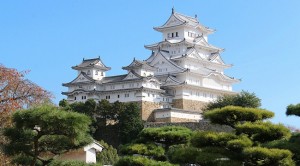Just about every weekend this semester, my roommate and I have made sure to go somewhere interesting, even if it isn’t far. We’ve traveled all through downtown Osaka together, through nearby Makino, all the way to Nara to see the oldest wooden buildings in the world, and most recently went to Himeji Castle (located near Kobe).
Himeji Castle is the largest, most popular castle in Japan and is regarded as the best surviving example of Japanese castle architecture. Arriving at Himeji Castle, I thought I had an idea of what to expect– I’ve been to Matsue Castle and Osaka Castle, so what could be so different?
Boy was I wrong.
The inside of Himeji Castle was like the waiting line for Test Track at Disney, complete with “Estimated Waiting Time: 45 minutes” signs, and a notice saying that the entire endeavor would take around 2 hours from start to finish. This, compared to the 30 minutes that it takes for someone to get through the entirety of Matsue Castle (going at a leisurely pace, mind you) was definitely one of the first clues I had that this castle was bound to be different.
Not only was the roof a brilliant white, but nearly everything on the outside was white– the walls, the stones, the sand, EVERYTHING. This, in addition to the fact that the layout of the castle means you are constantly looking upward at the main keep and that you have to go through various passages just to get there gave it a feeling entirely different from any other castle I’ve seen so far. Rather than feeling like a really big house surrounded by huge walls, this place actually gave a feeling of authority, and I would go so far as to say it was intimidatingly awe-some.
Walking at a slow pace through the castle (not entirely by choice, but more because the castle had reached maximum capacity and we were forced to move at the pace of the crowd) I was given a unique opportunity to really force myself to look at the craftsmanship I was surrounded by. All of the decorative wooden and stone tiles had been carved bearing various patterns– floral patters, organic patterns, geometric patterns, and even some butterfly insignias– and it’s remarkable that all of this was done, painstakingly, by hand, thousands upon thousands of times. The building itself was both beautiful and functional, and even the seemingly useless spaces of rooms were put to good use, whether it was with making secret passages for warriors to slip into when under duress, or whether it was in making slits for ammunition to be fired out of, or to provide enough windows to where you could have an almost unimpaired view of the surrounding country.
To think that I almost decided to stay home and work on schoolwork instead! Himeji may be a way’s away, but it’s a trip that you wouldn’t want to miss for anything.

